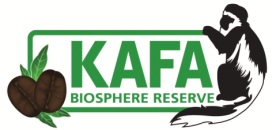WILDLIFE
In December 2014, the German Nature and Biodiversity Conservation Union (NABU) conducted an International Biodiversity Assessment in the Kafa Biosphere Reserve. A team of Ethiopian, German and Dutch experts as well as numerous field guides explored the species variety in Kafa and discovered new, endemic species. Their findings show that the Biosphere Reserve exhibits an extraordinary wealth of wildlife. From large majestic lions to tiny spotted frogs, Kafa supports a wide range of mammals, amphibians, reptiles, and invertebrates. Visitors in Kafa awake in the morning to the symphonies of birds and the croaks of the ibis.
Please find more information on the Biodiversity Assessment in German and English.
MAMMALS
In the Kafa Biosphere Reserve scientists have recorded 300 mammal species, including 14 kinds of carnivores. These species include: four types of mongoose, antelopes such as the Reedbuck and Duiker, seven types of bats, the small Rock Hyrax, who is the closest living relative of the elephant, Spotted Hyena, bushpig, Honey Badger, jackal, and the occasional riverine hippo and African Buffalo.

Kafa has a high density of primates. Five species of monkeys thrive here who have cheek-pouches, which expand to allow food storage, including the Grivet Monkey, the canopy-dwelling Blue or Gentle Monkey, De Brazza’s Monkey who uses grooming as a key part of social behaviour, the ground-feeding Olive Baboon, and the Vervet Monkey who exhibit altruistic behaviour when making warning calls. The nocturnal Senegal Bush Baby also enjoys Kafa’s habitats. Primates play a pivotal role in the germination of forest seeds and in fertilizing coffee seeds. Colobus monkeys (Colobus guereza ssp. gallarum) repre-sent the most striking primate of the region. It has glossy black fur with distinctive white patches and a full tuft of white at the end of its tail. The tree-dwelling colobuses eat mainly leaves, live in groups of 6-9 animals and space out from other groups by sounding choruses at dawn and dusk. Kafa’s people have a great admiration for the Colobus due to their fur, which is respectfully used by monks.

Also wild cats flourish in Kafa: the small African Wildcat, which resembles the house cat, African Civets, and the lesser-known Serval are all active at night. Lions are regularly seen in Kafa's highland forests. People highly respect lions and address them as kings. Smaller than the lion but no less impressive are leopards that can run up to 58 kilometres per hour and use this speed to overtake prey such as ante-lopes and monkeys. Known for its climbing ability and fondness of resting in trees, the leopard is at home in Kafa’s Afromontane forest.
AMPHIBIANS, REPTILES and INVERTEBRATES
In Kafa, researchers found seven different amphibians, six fish species and ten reptiles. Numerous colourful butterfly species also roam the area. The well-watered highlands make an ideal location for water-dependant amphibians. Both, amphibians and reptiles, play an important role in the forest ecosystem by controlling pests, insects, and rodents.
Reptiles depend on outside sources of heat and can often be seen basking in the sun. Interesting reptiles in the Biosphere Reserve include the small, swift-moving Common House Gecko, the rare nonvenomous African Python, one of the world’s largest species of snakes but endangered because people use its skin to make shoes and belts, and the rare Montane Chameleon, which moves slowly in trees and possess an ability to change its skin colour.
For more information, download a list of wildlife species in Kafa here from Berhan, L. A., (2008). Status and Distribution of Faunal Diversity in Kafa Report. Presented to PPP Project. For the full Faunal Diversity Report, please refer to the Download section.
